Case Based Questions Test: Laws of Motion - NEET MCQ
10 Questions MCQ Test Topic-wise MCQ Tests for NEET - Case Based Questions Test: Laws of Motion
Newton's Cradle
The device consists of a row of five metal balls positioned to just barely touch one another suspended from a frame by thin wires. On a small cradles, the balls are hung from the crossbars by light wire, with the balls at the point of an inverted triangle. This ensures that the balls can only swing in one plane, parallel to the crossbars. If the ball could move on any other plane, it would impart less energy to the other balls in the impact or miss them altogether, and the device wouldn't work as well, if at all. All the balls are, ideally, exactly the same size, weight, mass and density. As long as the balls are all the same size and density, they can be as big or as small as you like. The balls must be perfectly aligned at the center to make the cradle work the best.

When a ball on one end of the cradle is pulled away from the others and then released, it strikes the next ball in the cradle, which remains motionless. But the last ball on the opposite end of the row is thrown into the air, then swings back to strike the other balls, starting the chain reaction again in reverse. This device illustrates the three main principles of Physics - conservation of energy, conservation of momentum and friction. Everything that moves has momentum equal to its mass multiplied by its velocity. Like energy, momentum is also conserved. Momentum is a vector quantity, when 1st ball hits 2nd ball, it's traveling in a specific direction, let's say east to west. This means that its momentum is also moving east to west. Any change in direction of the motion brings a change in the momentum, which cannot happen without the influence of an outside force. That is why 1st ball doesn't simply bounce off 2nd ball, the momentum carries the energy through all the balls in a westward direction. It is to remember that the law of conservation only works in a closed system, which is free from any external force. The Newton's cradle is not a closed system. When 5th ball swings out away from the rest of the balls, it is affected by the force of gravity, which brings the ball down. But, the horizontal line of balls at rest, functions as a closed system, free from any influence of any force other than gravity. It's here, during the small time between the first ball's impact and the 5th ball swinging out, that momentum is conserved.
Newton’s cradle illustrates the three main principles of Physics:

Newton's Cradle
The device consists of a row of five metal balls positioned to just barely touch one another suspended from a frame by thin wires. On a small cradles, the balls are hung from the crossbars by light wire, with the balls at the point of an inverted triangle. This ensures that the balls can only swing in one plane, parallel to the crossbars. If the ball could move on any other plane, it would impart less energy to the other balls in the impact or miss them altogether, and the device wouldn't work as well, if at all. All the balls are, ideally, exactly the same size, weight, mass and density. As long as the balls are all the same size and density, they can be as big or as small as you like. The balls must be perfectly aligned at the center to make the cradle work the best.
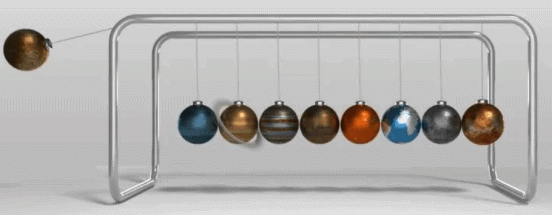
When a ball on one end of the cradle is pulled away from the others and then released, it strikes the next ball in the cradle, which remains motionless. But the last ball on the opposite end of the row is thrown into the air, then swings back to strike the other balls, starting the chain reaction again in reverse. This device illustrates the three main principles of Physics - conservation of energy, conservation of momentum and friction. Everything that moves has momentum equal to its mass multiplied by its velocity. Like energy, momentum is also conserved. Momentum is a vector quantity, when 1st ball hits 2nd ball, it's traveling in a specific direction, let's say east to west. This means that its momentum is also moving east to west. Any change in direction of the motion brings a change in the momentum, which cannot happen without the influence of an outside force. That is why 1st ball doesn't simply bounce off 2nd ball, the momentum carries the energy through all the balls in a westward direction. It is to remember that the law of conservation only works in a closed system, which is free from any external force. The Newton's cradle is not a closed system. When 5th ball swings out away from the rest of the balls, it is affected by the force of gravity, which brings the ball down. But, the horizontal line of balls at rest, functions as a closed system, free from any influence of any force other than gravity. It's here, during the small time between the first ball's impact and the 5th ball swinging out, that momentum is conserved.
When the 1st ball at one end of the cradle is pulled away and then released, then

| 1 Crore+ students have signed up on EduRev. Have you? Download the App |
Newton's Cradle
The device consists of a row of five metal balls positioned to just barely touch one another suspended from a frame by thin wires. On a small cradles, the balls are hung from the crossbars by light wire, with the balls at the point of an inverted triangle. This ensures that the balls can only swing in one plane, parallel to the crossbars. If the ball could move on any other plane, it would impart less energy to the other balls in the impact or miss them altogether, and the device wouldn't work as well, if at all. All the balls are, ideally, exactly the same size, weight, mass and density. As long as the balls are all the same size and density, they can be as big or as small as you like. The balls must be perfectly aligned at the center to make the cradle work the best.
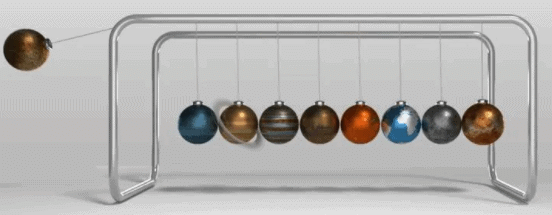
When a ball on one end of the cradle is pulled away from the others and then released, it strikes the next ball in the cradle, which remains motionless. But the last ball on the opposite end of the row is thrown into the air, then swings back to strike the other balls, starting the chain reaction again in reverse. This device illustrates the three main principles of Physics - conservation of energy, conservation of momentum and friction. Everything that moves has momentum equal to its mass multiplied by its velocity. Like energy, momentum is also conserved. Momentum is a vector quantity, when 1st ball hits 2nd ball, it's traveling in a specific direction, let's say east to west. This means that its momentum is also moving east to west. Any change in direction of the motion brings a change in the momentum, which cannot happen without the influence of an outside force. That is why 1st ball doesn't simply bounce off 2nd ball, the momentum carries the energy through all the balls in a westward direction. It is to remember that the law of conservation only works in a closed system, which is free from any external force. The Newton's cradle is not a closed system. When 5th ball swings out away from the rest of the balls, it is affected by the force of gravity, which brings the ball down. But, the horizontal line of balls at rest, functions as a closed system, free from any influence of any force other than gravity. It's here, during the small time between the first ball's impact and the 5th ball swinging out, that momentum is conserved.
When the momentum is conserved in Newton’s cradle?

Newton's Cradle
The device consists of a row of five metal balls positioned to just barely touch one another suspended from a frame by thin wires. On a small cradles, the balls are hung from the crossbars by light wire, with the balls at the point of an inverted triangle. This ensures that the balls can only swing in one plane, parallel to the crossbars. If the ball could move on any other plane, it would impart less energy to the other balls in the impact or miss them altogether, and the device wouldn't work as well, if at all. All the balls are, ideally, exactly the same size, weight, mass and density. As long as the balls are all the same size and density, they can be as big or as small as you like. The balls must be perfectly aligned at the center to make the cradle work the best.
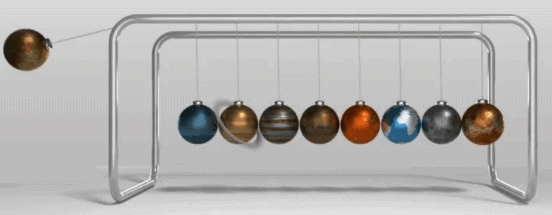
When a ball on one end of the cradle is pulled away from the others and then released, it strikes the next ball in the cradle, which remains motionless. But the last ball on the opposite end of the row is thrown into the air, then swings back to strike the other balls, starting the chain reaction again in reverse. This device illustrates the three main principles of Physics - conservation of energy, conservation of momentum and friction. Everything that moves has momentum equal to its mass multiplied by its velocity. Like energy, momentum is also conserved. Momentum is a vector quantity, when 1st ball hits 2nd ball, it's traveling in a specific direction, let's say east to west. This means that its momentum is also moving east to west. Any change in direction of the motion brings a change in the momentum, which cannot happen without the influence of an outside force. That is why 1st ball doesn't simply bounce off 2nd ball, the momentum carries the energy through all the balls in a westward direction. It is to remember that the law of conservation only works in a closed system, which is free from any external force. The Newton's cradle is not a closed system. When 5th ball swings out away from the rest of the balls, it is affected by the force of gravity, which brings the ball down. But, the horizontal line of balls at rest, functions as a closed system, free from any influence of any force other than gravity. It's here, during the small time between the first ball's impact and the 5th ball swinging out, that momentum is conserved.
In Newton’s cradle, the balls are hung from the crossbars by light wire, with the balls at the point of an inverted triangle. This ensures
Newton's Cradle
The device consists of a row of five metal balls positioned to just barely touch one another suspended from a frame by thin wires. On a small cradles, the balls are hung from the crossbars by light wire, with the balls at the point of an inverted triangle. This ensures that the balls can only swing in one plane, parallel to the crossbars. If the ball could move on any other plane, it would impart less energy to the other balls in the impact or miss them altogether, and the device wouldn't work as well, if at all. All the balls are, ideally, exactly the same size, weight, mass and density. As long as the balls are all the same size and density, they can be as big or as small as you like. The balls must be perfectly aligned at the center to make the cradle work the best.

When a ball on one end of the cradle is pulled away from the others and then released, it strikes the next ball in the cradle, which remains motionless. But the last ball on the opposite end of the row is thrown into the air, then swings back to strike the other balls, starting the chain reaction again in reverse. This device illustrates the three main principles of Physics - conservation of energy, conservation of momentum and friction. Everything that moves has momentum equal to its mass multiplied by its velocity. Like energy, momentum is also conserved. Momentum is a vector quantity, when 1st ball hits 2nd ball, it's traveling in a specific direction, let's say east to west. This means that its momentum is also moving east to west. Any change in direction of the motion brings a change in the momentum, which cannot happen without the influence of an outside force. That is why 1st ball doesn't simply bounce off 2nd ball, the momentum carries the energy through all the balls in a westward direction. It is to remember that the law of conservation only works in a closed system, which is free from any external force. The Newton's cradle is not a closed system. When 5th ball swings out away from the rest of the balls, it is affected by the force of gravity, which brings the ball down. But, the horizontal line of balls at rest, functions as a closed system, free from any influence of any force other than gravity. It's here, during the small time between the first ball's impact and the 5th ball swinging out, that momentum is conserved.
What is a closed system?
Bearing:
Bearings are used to convert sliding friction into rolling friction. Metal-upon-metal contact produces large amounts of friction. The friction adds to wear and tear of the metal, producing grinding that slowly degrades the metal. Bearings reduce friction by having the two surfaces roll over each other. They consist of a smooth metal ball or roller that rolls against a smooth inner and outer metal surface. The rollers or balls take the load, allowing by the device to spin. The two basic types of rolling element distinguish the two basic types of rolling bearing:
• ball → ball bearing
• roller → roller bearing
Balls make point contact with the ring raceways. With increasing load acting on the bearing, the contact point becomes an elliptical area. The small contact area provides low rolling friction, which enables ball bearings to accommodate high speeds but also limits their load-carrying capacity.
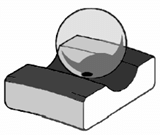
Rollers make line contact with the ring raceways. With increasing load acting on the bearing, the contact line becomes somewhat rectangular in shape. Because of the larger contact area and the consequently higher friction, a roller bearing can accommodate heavier loads, but lower speeds, than a same-sized ball bearing.

Bearing converts
Bearing:
Bearings are used to convert sliding friction into rolling friction. Metal-upon-metal contact produces large amounts of friction. The friction adds to wear and tear of the metal, producing grinding that slowly degrades the metal. Bearings reduce friction by having the two surfaces roll over each other. They consist of a smooth metal ball or roller that rolls against a smooth inner and outer metal surface. The rollers or balls take the load, allowing by the device to spin. The two basic types of rolling element distinguish the two basic types of rolling bearing:
• ball → ball bearing
• roller → roller bearing
Balls make point contact with the ring raceways. With increasing load acting on the bearing, the contact point becomes an elliptical area. The small contact area provides low rolling friction, which enables ball bearings to accommodate high speeds but also limits their load-carrying capacity.
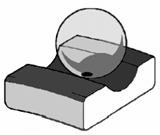
Rollers make line contact with the ring raceways. With increasing load acting on the bearing, the contact line becomes somewhat rectangular in shape. Because of the larger contact area and the consequently higher friction, a roller bearing can accommodate heavier loads, but lower speeds, than a same-sized ball bearing.
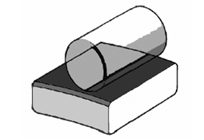
In ball bearing, contacts are
Bearing:
Bearings are used to convert sliding friction into rolling friction. Metal-upon-metal contact produces large amounts of friction. The friction adds to wear and tear of the metal, producing grinding that slowly degrades the metal. Bearings reduce friction by having the two surfaces roll over each other. They consist of a smooth metal ball or roller that rolls against a smooth inner and outer metal surface. The rollers or balls take the load, allowing by the device to spin. The two basic types of rolling element distinguish the two basic types of rolling bearing:
• ball → ball bearing
• roller → roller bearing
Balls make point contact with the ring raceways. With increasing load acting on the bearing, the contact point becomes an elliptical area. The small contact area provides low rolling friction, which enables ball bearings to accommodate high speeds but also limits their load-carrying capacity.
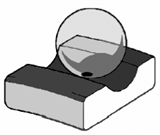
Rollers make line contact with the ring raceways. With increasing load acting on the bearing, the contact line becomes somewhat rectangular in shape. Because of the larger contact area and the consequently higher friction, a roller bearing can accommodate heavier loads, but lower speeds, than a same-sized ball bearing.
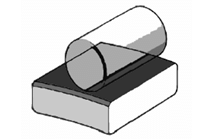
In roller contacts are
Bearing:
Bearings are used to convert sliding friction into rolling friction. Metal-upon-metal contact produces large amounts of friction. The friction adds to wear and tear of the metal, producing grinding that slowly degrades the metal. Bearings reduce friction by having the two surfaces roll over each other. They consist of a smooth metal ball or roller that rolls against a smooth inner and outer metal surface. The rollers or balls take the load, allowing by the device to spin. The two basic types of rolling element distinguish the two basic types of rolling bearing:
• ball → ball bearing
• roller → roller bearing
Balls make point contact with the ring raceways. With increasing load acting on the bearing, the contact point becomes an elliptical area. The small contact area provides low rolling friction, which enables ball bearings to accommodate high speeds but also limits their load-carrying capacity.
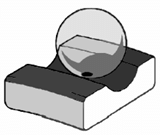
Rollers make line contact with the ring raceways. With increasing load acting on the bearing, the contact line becomes somewhat rectangular in shape. Because of the larger contact area and the consequently higher friction, a roller bearing can accommodate heavier loads, but lower speeds, than a same-sized ball bearing.
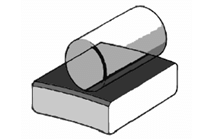
With increasing load on ball bearing the contact point
Bearing:
Bearings are used to convert sliding friction into rolling friction. Metal-upon-metal contact produces large amounts of friction. The friction adds to wear and tear of the metal, producing grinding that slowly degrades the metal. Bearings reduce friction by having the two surfaces roll over each other. They consist of a smooth metal ball or roller that rolls against a smooth inner and outer metal surface. The rollers or balls take the load, allowing by the device to spin. The two basic types of rolling element distinguish the two basic types of rolling bearing:
• ball → ball bearing
• roller → roller bearing
Balls make point contact with the ring raceways. With increasing load acting on the bearing, the contact point becomes an elliptical area. The small contact area provides low rolling friction, which enables ball bearings to accommodate high speeds but also limits their load-carrying capacity.

Rollers make line contact with the ring raceways. With increasing load acting on the bearing, the contact line becomes somewhat rectangular in shape. Because of the larger contact area and the consequently higher friction, a roller bearing can accommodate heavier loads, but lower speeds, than a same-sized ball bearing.

With increasing load on roller bearing the contact line
|
9 docs|1272 tests
|

















